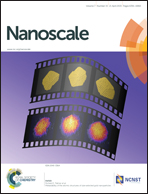Simultaneous effects of surface spins: rarely large coercivity, high remanence magnetization and jumps in the hysteresis loops observed in CoFe2O4 nanoparticles
Abstract
Well-dispersed uniform cobalt ferrite nanoparticles were synthesized by thermal decomposition of a metal–organic salt in organic solvent with a high boiling point. Some of the nanoparticles were diluted in a SiO2 matrix and then the undiluted and diluted samples were characterized and their magnetic behavior explored. The undiluted and diluted samples exhibited maximum coercivity Hc of 23 817 and 15 056 Oe at 10 K, respectively, which are the highest values reported to date, and the corresponding ratios of remanence (Mr) to saturation (Ms) magnetization (Mr/Ms) were as high as 0.85 and 0.76, respectively. Interestingly, the magnetic properties of the samples changed at 200 K, which was observed in magnetic hysteresis M(H) loops and zero-field cooling curves as well as the temperature dependence of Hc, Mr/Ms, anisotropy, dipolar field, and the magnetic grain size. Below 200 K, both samples have large effective anisotropy, which arises from the surface spins, resulting in large Hc and Mr/Ms. Above 200 K, the effective anisotropy decreases because there is no contribution from surface spins, while the dipolar interaction increases, resulting in small Hc and Mr/Ms. Our results indicate that strong anisotropy and weak dipolar interaction tend to increase Hc and Mr/Ms, and also clarify that the jumps around H = 0 in M(H) loops can be attributed to the reorientation of surface spins. This work exposes the underlying mechanism in nanoscale magnetic systems, which should lead to improved magnetic performance.


 Please wait while we load your content...
Please wait while we load your content...